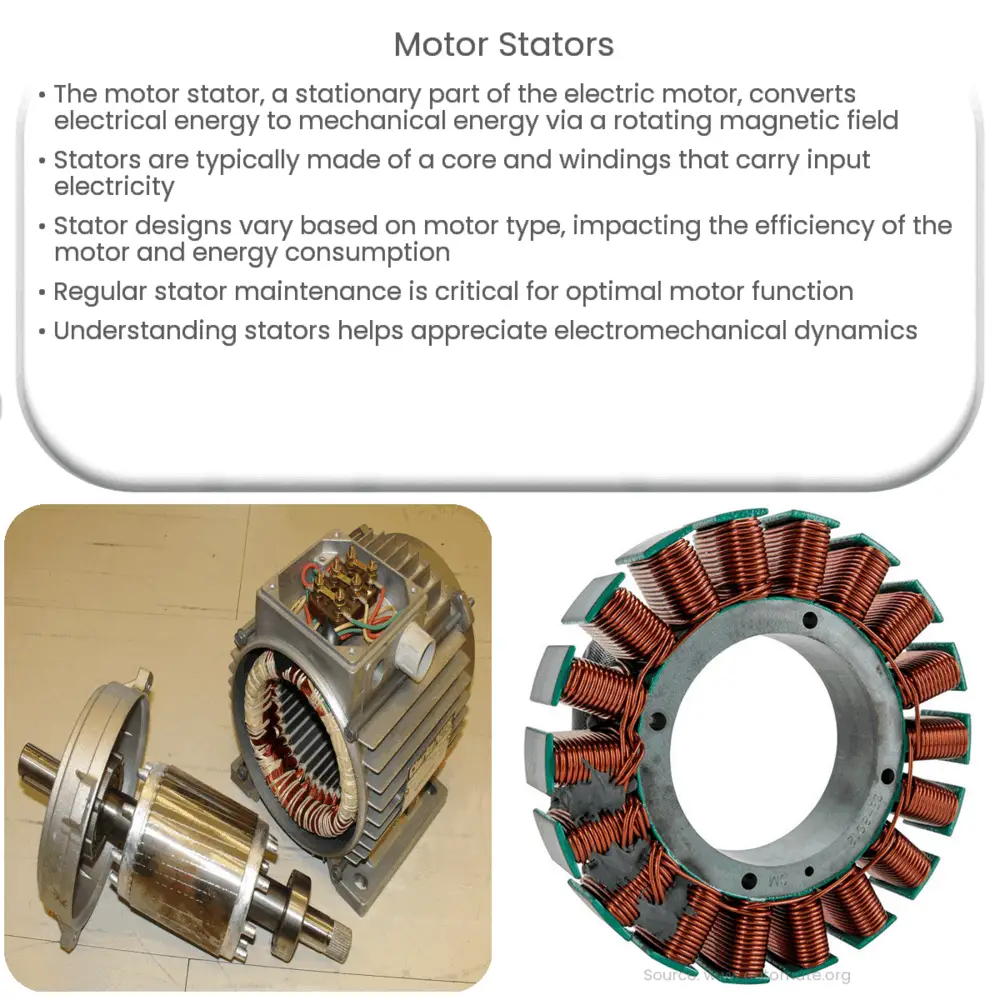Explore the crucial role of motor stators in electric motors, their design, function, maintenance, and impact on energy efficiency.

Introduction to Motor Stators
The fundamental building block of any electric motor is the stator, a crucial component that remains stationary and plays a pivotal role in the operation of the motor. In this article, we’ll delve into the intricacies of motor stators, including their design, function, and significance in motor operations.
Understanding Motor Stators
The term ‘stator’ originates from the Latin word ‘stare’, which means ‘to stand’. As its name implies, the stator is the stationary part of an electric motor, constructed within the motor’s housing. Conversely, the rotor, or the rotating part of the motor, moves in response to the magnetic field generated by the stator.
The Design of a Motor Stator
The typical motor stator consists of two main parts: the stator core and the windings. The stator core, typically made from laminated soft iron magnetic cores to reduce energy losses, provides a controlled path for the magnetic flux. The windings, made from copper or aluminum wire, are inserted into the stator core and are where the input electricity is applied.
Function of a Motor Stator
The primary function of the motor stator is to generate a rotating magnetic field. This is accomplished by alternating current (AC) through the windings. The alternating current creates a magnetic field that moves in time with the oscillations. Because the stator is a part of an electromagnetic system, it adheres to the right-hand rule for electromagnetism. Thus, when current passes through the stator windings, it generates a magnetic field around the wire.
- 1The rotor, being magnetically linked to the stator, follows this magnetic field, resulting in rotation.
- 2Consequently, the rotor transfers this mechanical power to whatever device the motor is intended to drive, such as a fan, a pump, or a conveyor belt.
In essence, the stator is the ‘heart’ of the motor that converts electrical energy into mechanical energy via magnetic interaction with the rotor.
Variations in Stator Design
While the basic design of a stator remains consistent, there are various forms and sizes depending on the specific type of motor. The number of windings and their configuration can differ significantly based on the motor’s purpose. In AC induction motors, the stator consists of three sets of windings to produce a three-phase rotating magnetic field. Conversely, in simple DC motors, the stator may just be composed of permanent magnets.
Stator in Synchronous and Asynchronous Motors
In synchronous motors, the rotor turns at the same speed as the rotating magnetic field produced by the stator. On the other hand, asynchronous (or induction) motors, the most commonly used type, operate on the principle of the rotor ‘lagging behind’ the speed of the stator’s rotating magnetic field.
Stator Maintenance
Maintaining the stator is critical for the optimal functioning of a motor. Over time, the windings may undergo degradation due to factors like heat, vibration, and age. Regular inspection for signs of wear and tear, excessive heat, or irregular noises can help ensure the motor’s longevity and performance.
The Stator’s Role in Energy Efficiency
It is essential to highlight that the design and condition of the stator significantly influence the efficiency of the motor. Efficient stators can help reduce energy consumption, contributing to overall energy savings and sustainability goals. Modern stators are often designed with materials and technologies aimed at maximizing efficiency and minimizing losses.
Conclusion
In conclusion, the motor stator is a vital component in any electric motor, playing an instrumental role in converting electrical energy into mechanical energy. Its design, maintenance, and efficiency greatly impact motor performance, energy consumption, and ultimately, the success of the applications they drive. Understanding the intricacies of motor stators aids in appreciating the complex dynamics of our electromechanical world, from everyday appliances to industrial machinery. After all, it is the silent efficiency of the motor stator that sets the world in motion.

